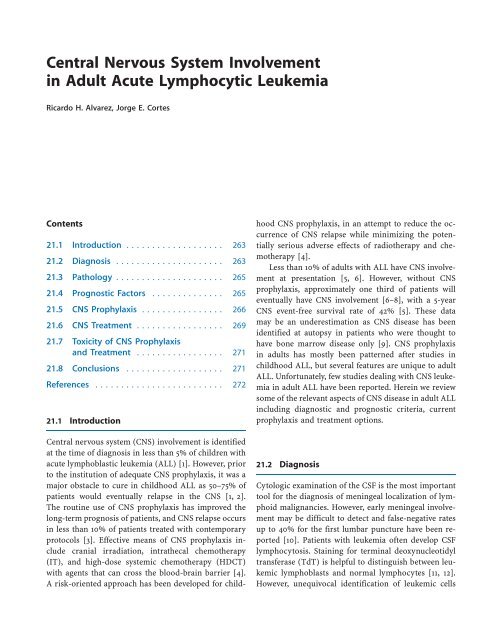Acute Leukemias - Republican Scientific Medical Library
Acute Leukemias - Republican Scientific Medical Library
Acute Leukemias - Republican Scientific Medical Library
You also want an ePaper? Increase the reach of your titles
YUMPU automatically turns print PDFs into web optimized ePapers that Google loves.
Central Nervous System Involvement<br />
in Adult <strong>Acute</strong> Lymphocytic Leukemia<br />
Ricardo H. Alvarez, Jorge E. Cortes<br />
Contents<br />
21.1 Introduction ................... 263<br />
21.2 Diagnosis ..................... 263<br />
21.3 Pathology ..................... 265<br />
21.4 Prognostic Factors .............. 265<br />
21.5 CNS Prophylaxis ................ 266<br />
21.6 CNS Treatment ................. 269<br />
21.7 Toxicity of CNS Prophylaxis<br />
and Treatment ................. 271<br />
21.8 Conclusions ................... 271<br />
References ......................... 272<br />
21.1 Introduction<br />
Central nervous system (CNS) involvement is identified<br />
at the time of diagnosis in less than 5% of children with<br />
acute lymphoblastic leukemia (ALL) [1]. However, prior<br />
to the institution of adequate CNS prophylaxis, it was a<br />
major obstacle to cure in childhood ALL as 50–75% of<br />
patients would eventually relapse in the CNS [1, 2].<br />
The routine use of CNS prophylaxis has improved the<br />
long-term prognosis of patients, and CNS relapse occurs<br />
in less than 10% of patients treated with contemporary<br />
protocols [3]. Effective means of CNS prophylaxis include<br />
cranial irradiation, intrathecal chemotherapy<br />
(IT), and high-dose systemic chemotherapy (HDCT)<br />
with agents that can cross the blood-brain barrier [4].<br />
A risk-oriented approach has been developed for child-<br />
hood CNS prophylaxis, in an attempt to reduce the occurrence<br />
of CNS relapse while minimizing the potentially<br />
serious adverse effects of radiotherapy and chemotherapy<br />
[4].<br />
Less than 10% of adults with ALL have CNS involvement<br />
at presentation [5, 6]. However, without CNS<br />
prophylaxis, approximately one third of patients will<br />
eventually have CNS involvement [6–8], with a 5-year<br />
CNS event-free survival rate of 42% [5]. These data<br />
may be an underestimation as CNS disease has been<br />
identified at autopsy in patients who were thought to<br />
have bone marrow disease only [9]. CNS prophylaxis<br />
in adults has mostly been patterned after studies in<br />
childhood ALL, but several features are unique to adult<br />
ALL. Unfortunately, few studies dealing with CNS leukemia<br />
in adult ALL have been reported. Herein we review<br />
some of the relevant aspects of CNS disease in adult ALL<br />
including diagnostic and prognostic criteria, current<br />
prophylaxis and treatment options.<br />
21.2 Diagnosis<br />
Cytologic examination of the CSF is the most important<br />
tool for the diagnosis of meningeal localization of lymphoid<br />
malignancies. However, early meningeal involvement<br />
may be difficult to detect and false-negative rates<br />
up to 40% for the first lumbar puncture have been reported<br />
[10]. Patients with leukemia often develop CSF<br />
lymphocytosis. Staining for terminal deoxynucleotidyl<br />
transferase (TdT) is helpful to distinguish between leukemic<br />
lymphoblasts and normal lymphocytes [11, 12].<br />
However, unequivocal identification of leukemic cells
















